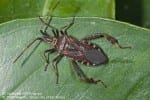
Courtesy: UCANR
Leaffooted bug has re-emerged as an issue for almond growers over the last two seasons and researchers say there is a specific time for California producers to monitor for leaffooted bug.
Leaffooted bug caused some issues for almond growers this last season. A weather change this winter might help control those rising populations, but Integrated Pest Management Advisor Kris Tollerup says growers still need to monitor for the pest, especially since the bug can aggregate in large populations. Tollerup says there is a specific time that growers should be monitoring and it’s a must do if their orchard is a neighbor of an overwintering host crop.
UC IPM Guidelines: Monitoring and Treatment Decisions
Walk the orchard during the months of March and April to look for dropped nutlets (particularly on susceptible varieties), nuts with gummosis, and leaffooted bugs. Finding adult bugs is the best indication that a problem may arise, but the cryptic nature of these pests and their behavior of staying in the tops of trees makes this difficult to do. A more practical approach is to look for nuts with gummosis or egg masses on the sides of nuts. If gummosis exists, cut a cross-section across the damaged site to look for a puncture mark from the bug’s mouthparts to confirm that the gummosis is not due to physiological reasons.
The easiest monitoring method is to look for aborted nuts on the ground. However, basing treatments on gummosis and nut drop also means that there can be a 7-10 day lag time between when feeding takes place and when gummosis and nut drop occur – so the dispersing insects may have already moved to another block. Get more monitoring tips at the UC IPM website.









